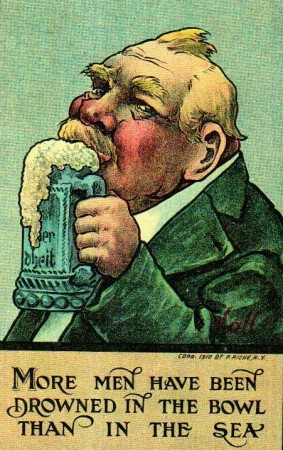
“J” – (Really the old German “I”) – When found stamped about the rim of an older stoneware steins (mostly the model [mud] steins from the Westerwald, this is part of the signification of measurement. It is the abbreviation of the old German word for ‘Inhalt” which means ‘capacity. So if one sees: “1/2 L J”, it means one half a liter capacity. When one see a “S ” this means “Summa” (Latin for sum) and usually precedes the volume = “S 1/2 L” (Thanks to Roy DeSelms, Prosit, 12-2010. for the verification of my thoughts I published about 25 years ago.)
Jacquot) and a Jacqueline – a pair of character servers; the man (Jacquot) and a woman (Jacqueline) are seen sitting on a mound (or a large rock.) This one made in Lille, FR. made of faience / delftware . Origin of the originals was mostly from northern France, or Belgium. This one above is a copy of the earlier 1600’s ot 1700’s version, but Circa late 1800’s.
NOTE: A PAIR OF THESE WERE CALLED “ORIENTALS” BY A USA STEIN AUCTIONEER IN 2015!!
THEY [ALL] ARE GETTING QUITE SLOOPY ON CALLING SOME PIECES CORRECTLY.
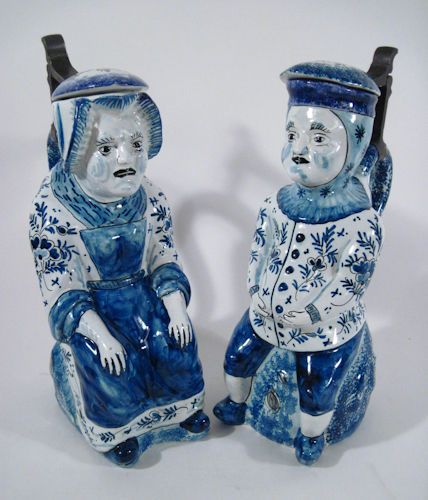
Jacqueline. and Jacquot [FWTD] Looking at the faces and colors these were probably not made by the same firm as those just below
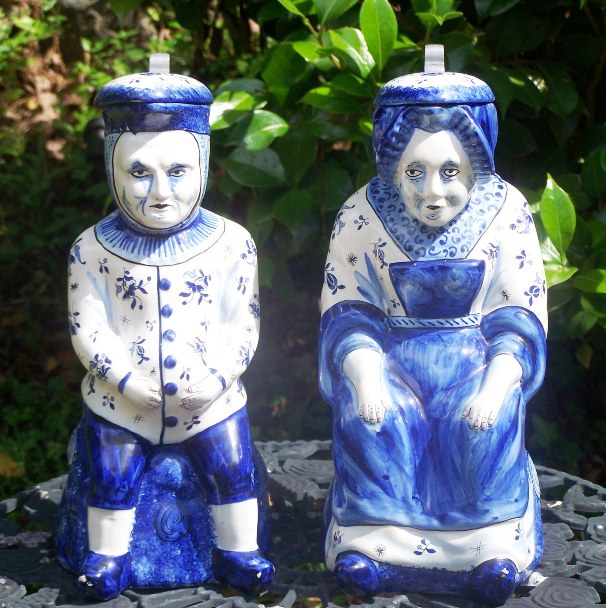
A newer set showing Jacquot and Jacqueline pitchers, French faience . Ca. 1950- 70. here’s what ebay seller “”XXX” had to say about these two =”a stunning blue and white pair of Jacqueline and Jacquot pitchers in French faience made for the Saks Fifth Avenue stores.[!] These are very heavy and 15 inches tall. Jacqueline is 6 1/2 inches across and Jacquot is 6 inches. The lids are surmounted with a metal like pewter, whether it is pewter, I am uncertain. Wonderful floral painting and my guess is that these are either by the DESVRES factory or possibly Moustiers.”
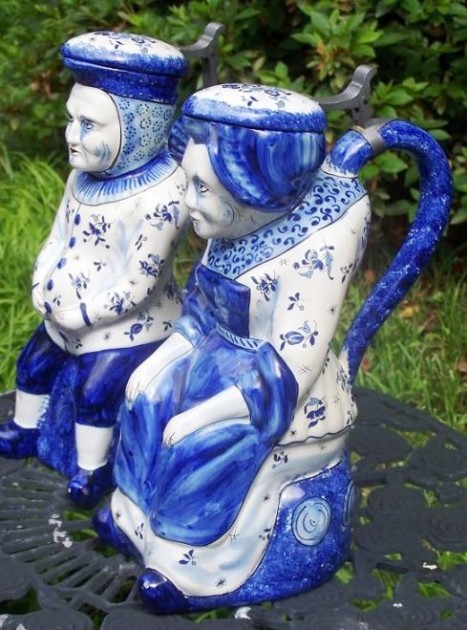
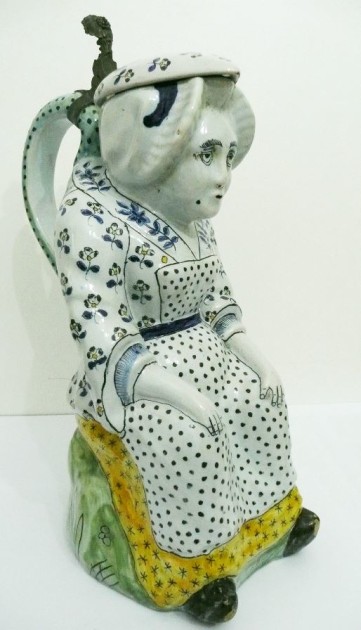
Above is a nice “Jacqueline pot ” seen on French eBay about the same time ” Ad said: of the second part of the eighteenth century origin . northern France.39.5 CM [15,8 inches tall] . Seller wanted 2, 200 euro to start bid.
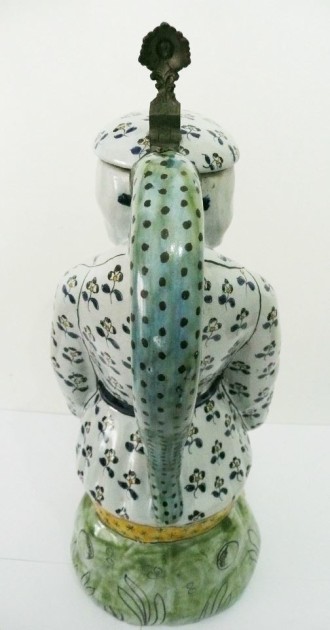
.
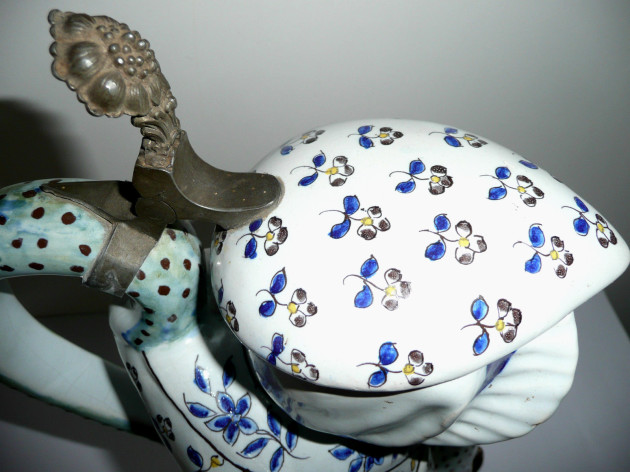
Lid detail – much more attractive workmanship on this, the oldest version shown so far
Below ▼A different style of Jacquot. He is un-lidded which is unusual, but also an original antique style B these below are circa early, to mid 1900’s .
![$-sos - DUTCH - Antique Pair of Dutch Delft Sculptures - Drinking Vessels - Sitting man on Barrel mokum 2000 see j and j for how i listed them as being. as oin char jugs [q]](http://www.steveonsteins.com/wp-content/uploads/2013/03/sos-DUTCH-Antique-Pair-of-Dutch-Delft-Sculptures-Drinking-Vessels-Sitting-man-on-Barrel-mokum-2000-see-j-and-j-for-how-i-listed-them-as-being.-as-oin-char-jugs-q.jpg)
Dutch “Daryl and his other brother Daryl”. =Dutch Characters. Copies of much earlier works (1600’s) made around the Dutch – French Border .
![$- sos - Dutch Delft S culpture- Drinking Vessel see j and j for what i called these mokum 2000 HAVE IN PAIR [Q]](http://www.steveonsteins.com/wp-content/uploads/2013/03/sos-Dutch-Delft-S-culpture-Drinking-Vessel-see-j-and-j-for-what-i-called-these-mokum-2000-HAVE-IN-PAIR-Q.jpg)
Sold only by himself on a different seller’s page. These are not uniquely painted as the ones from the 1600;s – 1700’s were.
Of course once one certain thing or style gets popular, someone has to copy it or use the idea in a new form. Enter Thewalt:
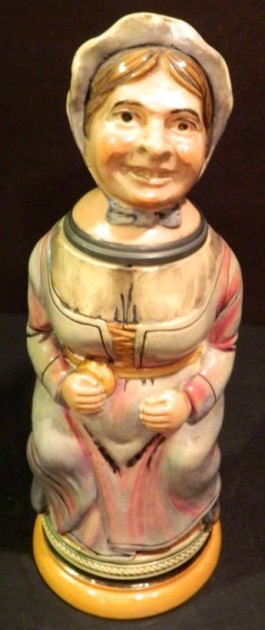
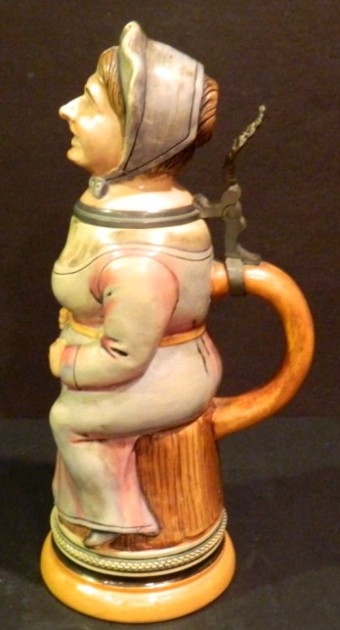
Thewalt character stein No 488. She is sitting on a stump not a rock.
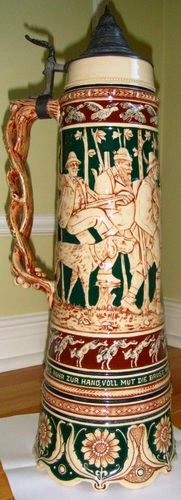
.
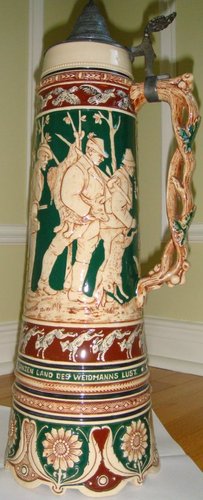
Jagd, — German for hunting, Shown: 19 inch pottery relief, most probably made by M. Girmscheid. See:
Jagdmotiven – German for a Hunter’s scene. An easy way to describe hunting scenes on beer steins.
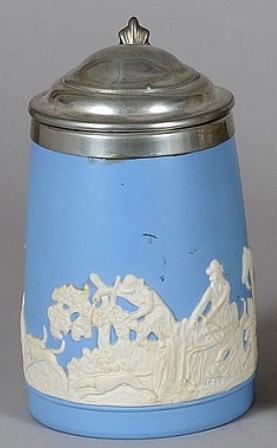
Jasper Ware – Jasperware, or jasper ware, is a type of stoneware first developed by Josiah Wedgwood, although some authorities have described it as a type of porcelain. It is noted for its matte finish and is produced in a number of different colors, of which the best known is a pale blue that has become known as ‘Wedgwood Blue’~ “Jasper” in this context refers to the mineral of that name. [http://en.wikipedia.org/wiki/Jasperware] Shown ▲: Jasperware stein by Daulton , English, height 6 1/4 in.
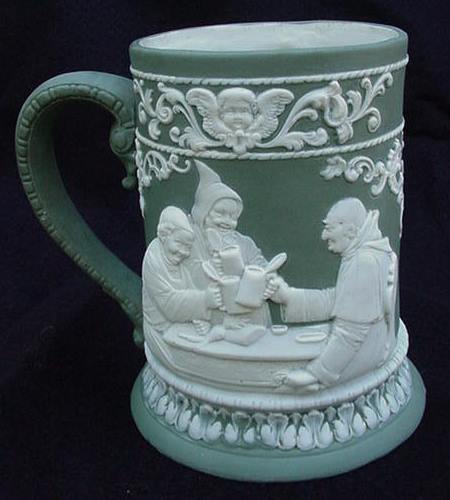
Jasperware beer mug, also by Daulton.
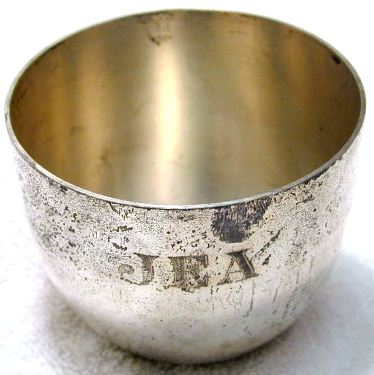
Jefferson Cup – A small, round bottomed cup with no handle. Originally made of silver, popular attribution (with no real evidence I have ever seen) claims this to have been invented / designed by the USA’s 3rd president, Thomas Jefferson. Shown: A tarnished 1967 sterling silver example by Stieff Silver in Baltimore. These are about 3 inches tall. Many, many examples can be found made of pewter.
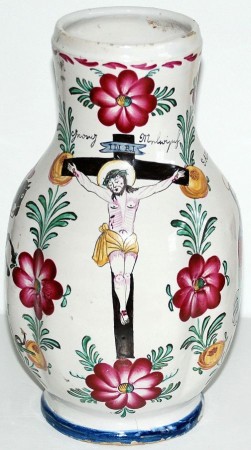
Jesus Christ (on) steins – If there is someone reading this that doesn’t know what this means, then it is time for them to transport back to their home planet!
Shown ▲: Austrian Fayence beer mug. Circa 1820.
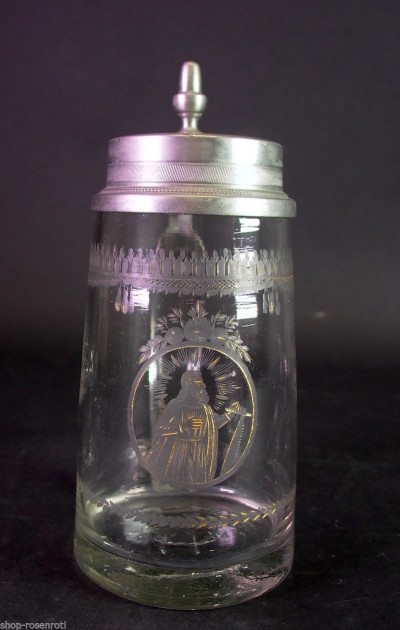
A new addition to [FWTD] JAN. 2016. CA. 1830
– “HE” IS SHOWN WITH A LONG SAW FOR CUTTING PLANKS.
For more of Saints /Holy Family/ etc. on steins, see: http://www.steveonsteins.com/when-the-saints-come-marching-in-singing-ein-prosit-ein-prosit-new-12-14-11
IHS – A monogram of the name of Jesus Christ The old Germans might have used ” J H S” AS THE I and the J were interchangeable.
Also see “Baby Jesus” in this compendium.
![SILVER STEIN - JEWELS 1590 to 1650 [Q] #1](http://www.steveonsteins.com/wp-content/uploads/2010/09/SILVER-STEIN-JEWELS-1590-to-1650-Q-1-297x450.jpg)
Jeweled steins / vessels – Fairly uncommon pieces as even the placement of semi-precious jewels has to increase the work-hours significantly on any piece. Shown Early 1600’s German, [.800?] silver stein. Unmarked, but the style of the thumblift amongst other things is the indicator to its advanced age. [FWTD]
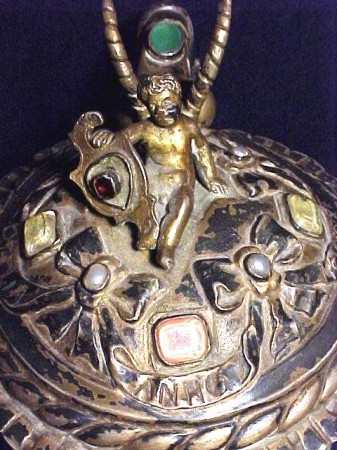
Lid before cleaning.
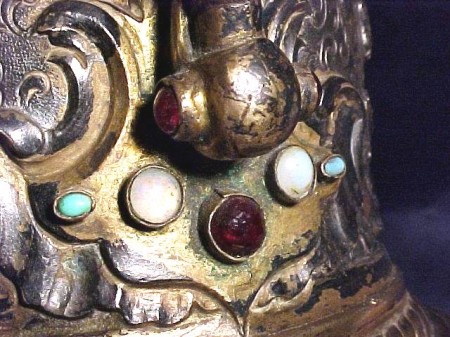
Detail of the great workmanship required and the remaining gilded surface after hundreds of years of use.
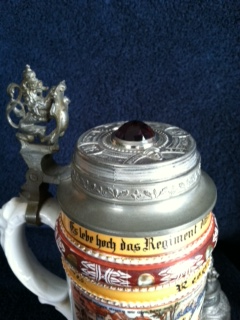
Jeweled lid – These are not real jewels, but cut colored glass. Most often found on German glass steins; this one is from a “screw off” lid on a Reservist stein. The color of the glass gives a different significance.
Please see: “Jeweled Lids ~Myths and Superstitions,” by Jim Sauer, at the SCI web site’s “Reading Room.”
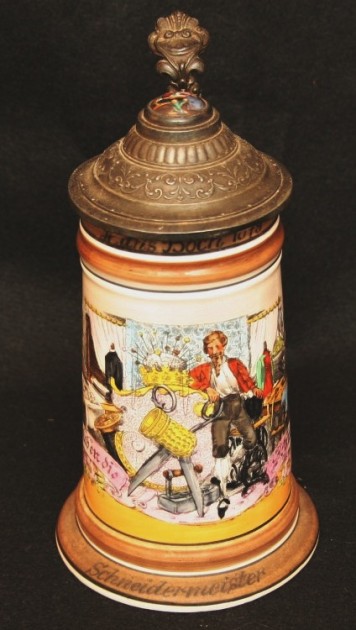
Shown ▲:A tailor’s reproduction an older lid with a glass “jewel” on top attached, which is much too big.
A waste of a good lid! Body made by Rau.
Jewish Star / Star of David – See: “Six sided star” in this site’s Compendium: S.
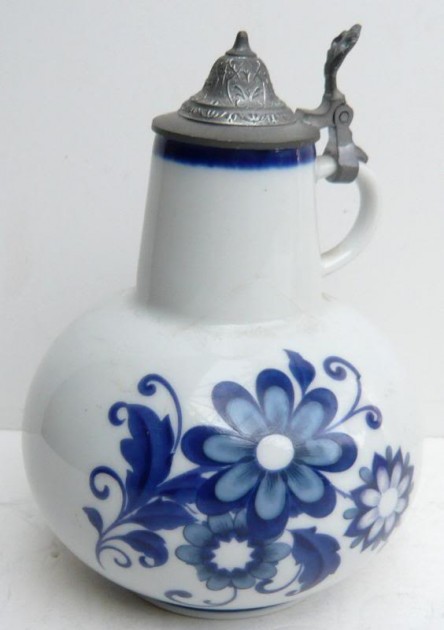
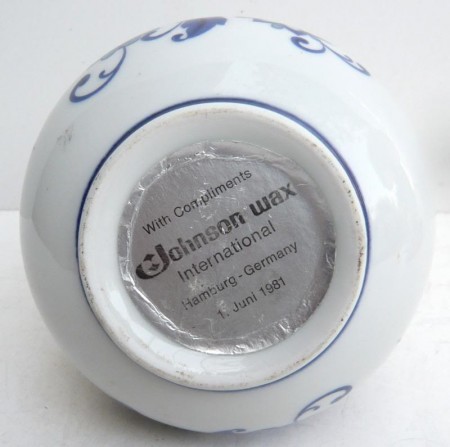
Johnson’s Wax – A cute .5 liter [?] give away stein. Quite different as not many American Companies are known to have given away beer steins this late; dated 1981. Before ‘Prohibition’ these gifts were quite common, but mostly done by the beer companies. This one was hopefully not used to hold the wax!
JHS – A monogram of the name of Jesus Christ The old Germans might have used I H S AS THE I and the J were interchangeable.
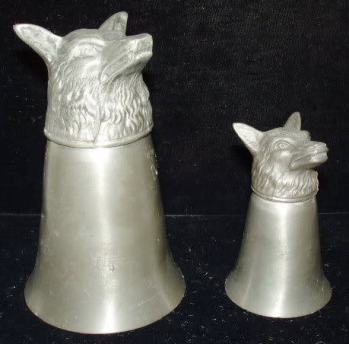
Jigger – A small cup, silver / glass / pewter used as a shot or double “shot glass”. Shown ▲: A couple of new pewter “Stirrup cups” that can / are used as jiggers here in the USA.
Josephinenhütte – A very well know glass firm. Shown: A tall enameled server that has been credited on eBay and other auction sites as being made by every glass firm in Bohemia and Silesia. It wasn’t until after the publishing of the book “Josephinenhütte” that this design was credited and documented to this firm. The enameled colors are very, very close to those that were used at “Theresienthal.”
For much more information on this firm see: http://www.steveonsteins.com/josephinenhutte-glass-drinking-vessels-at-the-s-m-t-draft-3-30
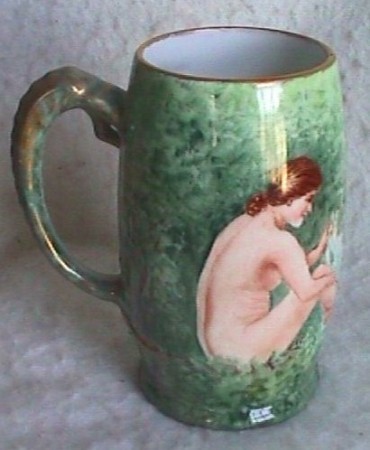
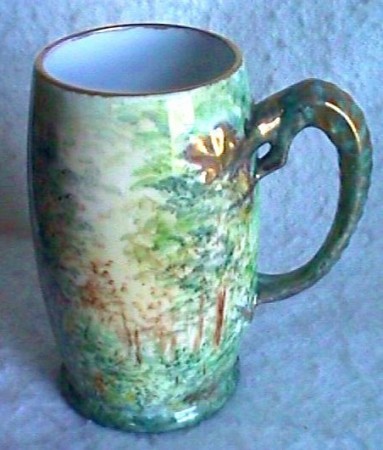
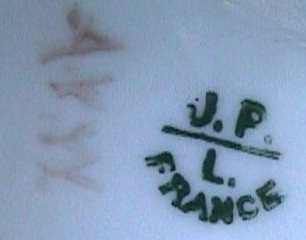
J. P., Limoge – Jean Pouyat; maker of some very nice [enamel added later] hand painted mugs in one of France’s porcealin ware centers, in the early 1900’s. SEE: http://www.steinmarks.co.uk/pages/pv.asp?p=stein1
Read more about J.P. @ and hand painting of mugs in America. http://www.pbs.org/wgbh/roadshow/archive/200402A11.html
J.R.M. – Josef Reinemann, München – A wholesaler of steins, a souvenir shop. His mark is found on several stein manufacturer’s products. Also JRM is stamped on the hinge pin of some steins. See: http://www.steinmarks.co.uk/pages/pv.asp?p=stein1

Judaica, Star – NOT!! See: “Brewer’s star” in this site’s “B” Compendium page.
Jungfraubechers = “Young Lady Beakers,” or Wedding / Marriage Cups (But Not Wager Cups!)
For a page on these guys , See: http://www.steveonsteins.com/wedding-cups
Jungfraujoch – In German it means ‘Virgin’s Yoke” – A notorious snow swept mountain in the alps; subject on many steins.
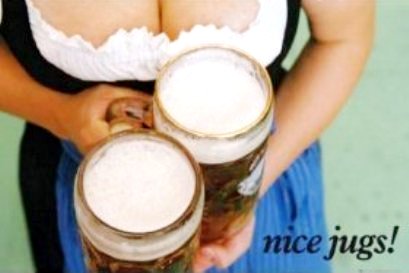
Jug, for beer / wine – In English, a really undefined shaped vessel for drinking or carrying beer or wine . They can range from the slang word for a large mug such as seen above ▲, to the medium large German Westerwalds “Pear Jugs” [see below] for carrying and then serving alcoholic liquids, that a lot of stein collectors enjoy, myself included.
To clarify things in my mind and to pigeonhole these terms, I use the word “Jug” to indicate the vessels that carries the beer / wine from the keg in the keller, or from the brew house down the street, or from the kitchen to the table (But I am guilty of interchanging the two words myself!)
The word “Server” is then used throughout this site for the vessel that sits on the table that one would use to pour from. A “Pitcher” would be used for a milk or water on the table pouring vessel. “Ewer” is just for water for washing one’s hands.
Also see: {1] Malling Jugs [2] Tiger ware [3] Ring Jugs [4] Melon Jug – all in this site’s Compendium.
Below ▼ are different examples of what I call jugs and don’t.
Shown: Some of the large “jugs” used for very special liquids for ions.
. .
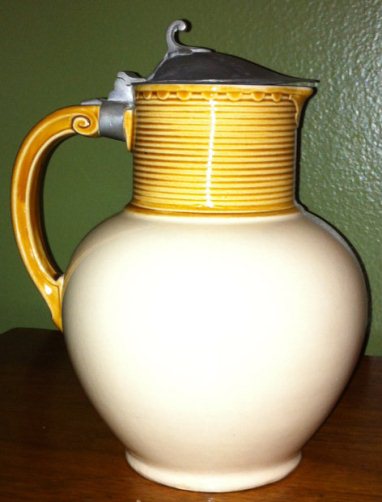
A V & B Mettlach “server”, not a jug, as it would have sat on the table.
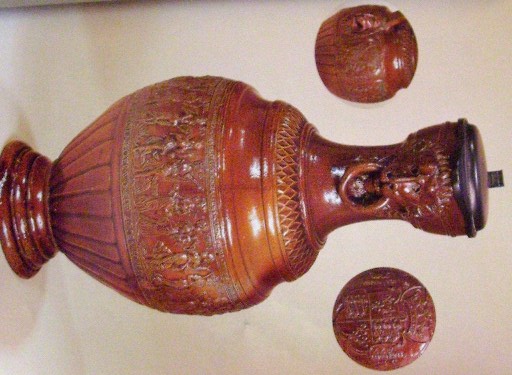
A stoneware jug with a “Ring in Mouth” (but not a “Ring Jug”.) Used to carry the liquid to the table. Raeren, 1577. [J Vogt]
For more on “Ring Jugs”, See: http://www.steveonsteins.com/some-of-the-beauties-of-the-westerwald-2
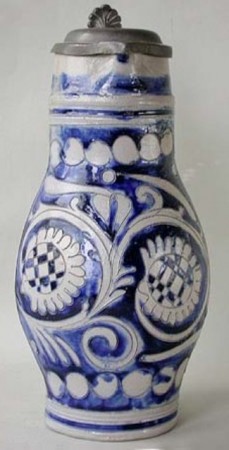
[▲] Westerwald incised stoneware “Pear Jug.” (Germ: Birnkrug) Circa 184o-60. This one is large (over 2 liters), now they did make some that are one to two liters which could have been used on the table.
[▼] A large 4 liter [?] Westerwald stoneware relief beer / wine jug. Circa 1880. Used to carry whatever liquid to the table. Way too cumbersome to serve drinks from:
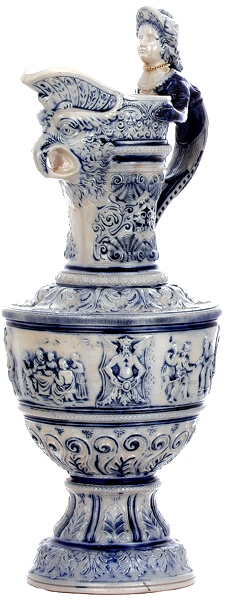
An extra large relief Westerwald beer jug, probably not used for either purpose, but just for decoration. The maker was R. Hanke.
.
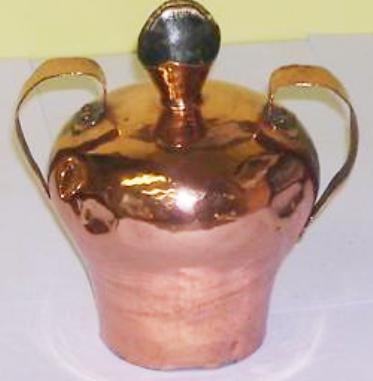
Jug, vodka – This is a Russian Copper “Vodka Jug,” very distinctive two handles and “eye cup” serving spout. I would think from a small barrel to the table but not used to pour into the small Russian vodka beakers which are usually the size of an English jigger. Circa 1870. 7.5 inches.
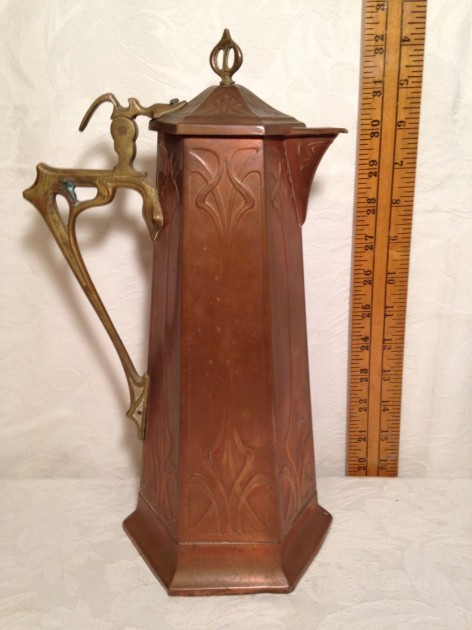
Yet another type of “Jug.” These tall slender mixed metals of this Art Deco / Jugendstil style are normally refereed to as “Claret Jugs .” [Claret being a type of wine.] As with all the other I will just refer to them as servers!
Jugendstil steins – Germany’s early 1900’s answer to a cross / a mix of Art Nouveau and Art Deco.
Jugendstil = youth style = modern art.
For more info and photos please see this brief article: http://www.stein-man.de/nouveau/nouveau%20.html
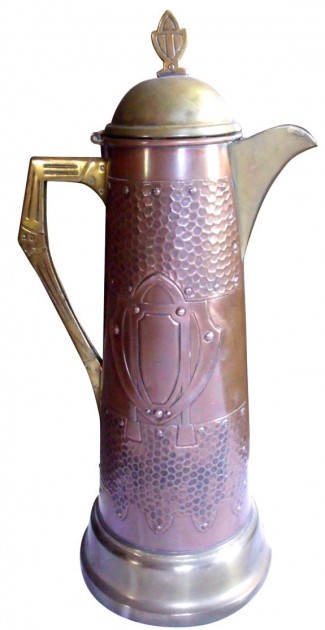
Copper (mostly ) with brass accents beer / wine server. A typical style for the Jugendstil period. See Jug above ▲.
[END – SP104 – 32 – R5]
 “By the time a man realizes that his father was right, he has a son who thinks he’s wrong.”
“By the time a man realizes that his father was right, he has a son who thinks he’s wrong.”

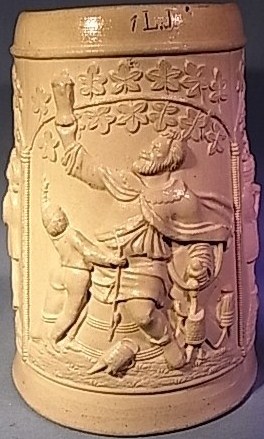
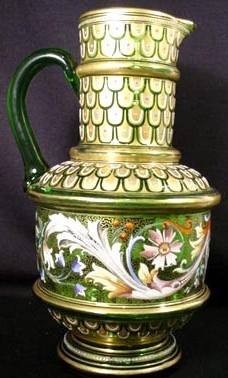
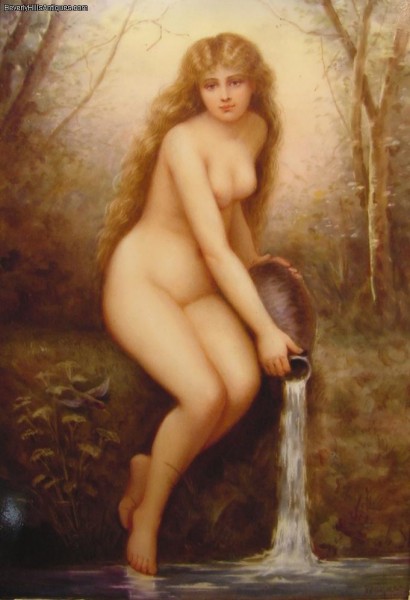
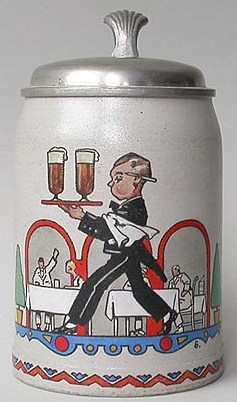
Leave a Reply